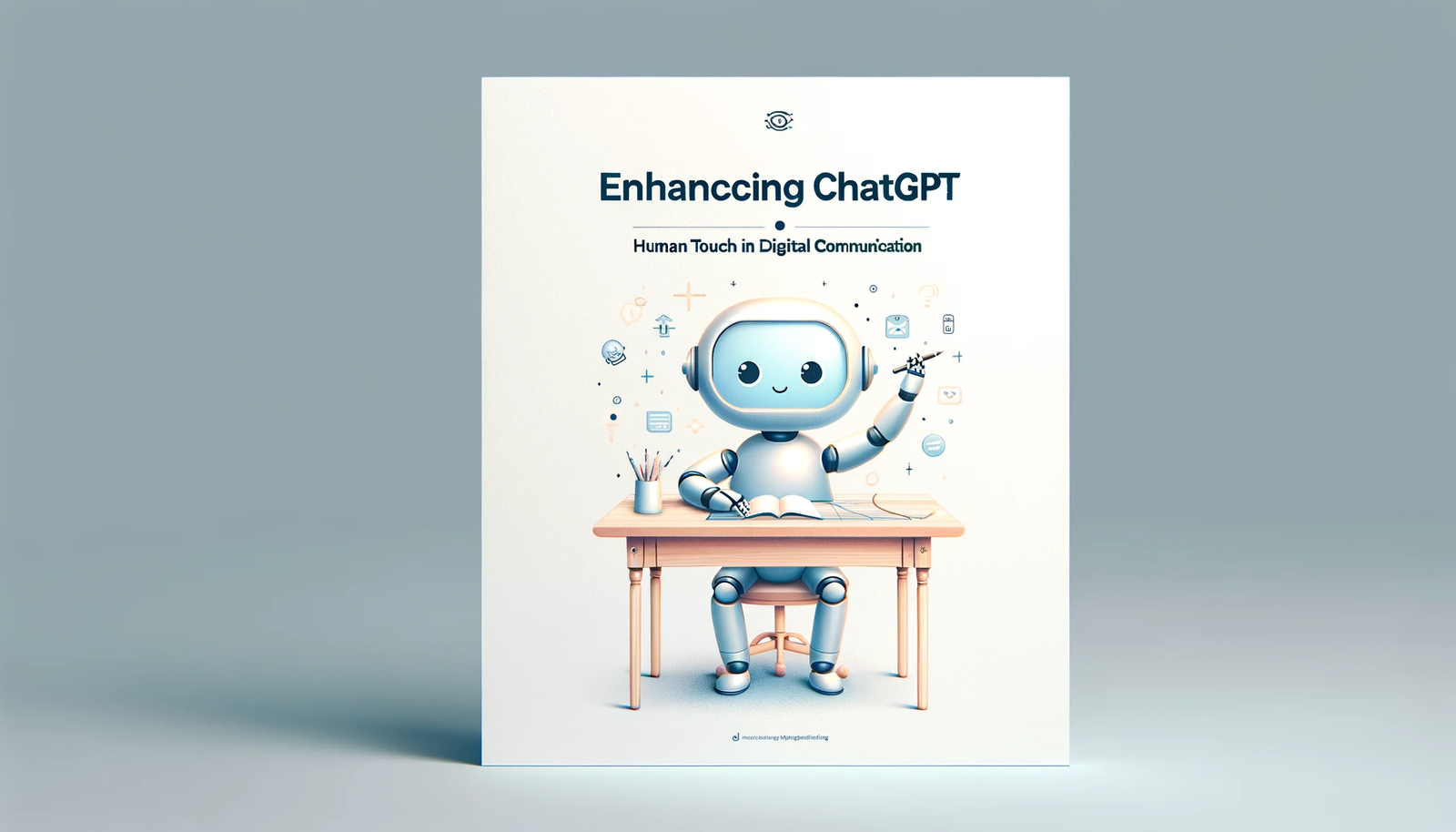Teaching ChatGPT to write like a human is a challenging yet fascinating task in the realm of artificial intelligence and language. This guide, focusing on “How to Make ChatGPT Write Like a Human,” delves into various methods, details, and strategies essential for enabling ChatGPT, an advanced AI language model, to emulate human-like writing and conversation. It navigates through the intricate process of achieving this ambitious goal, examining AI communication and striving to integrate advanced technology with authentic human expression to create a seamless and naturally resonating experience.
Table of Contents
Understanding the Foundation: ChatGPT’s Language Model
ChatGPT generates text using a smart language model called GPT, which is built on OpenAI’s advanced architecture. This section will explore the technical intricacies of the model, detailing how it processes and generates language. We will explore how AI learns from different datasets to predict and create relevant responses.
Humanizing ChatGPT: Key Techniques and Strategies
Making ChatGPT’s responses more human-like involves a multifaceted approach. This part will discuss various techniques to enhance the model’s natural language generation capabilities. We will cover the integration of idiomatic expressions, understanding emotional cues, adapting conversational tones, and responding with empathy. Each aspect contributes significantly to making ChatGPT’s output more relatable and engaging for human users.
Emotional Intelligence: The Heart of Human-like AI Writing
Emotional intelligence is a cornerstone in humanizing AI. This segment will examine the training methodologies enabling ChatGPT to recognize and aptly respond to emotional nuances. The model will learn to understand context, tone, and sentiment in conversations. This will enable it to have more empathetic and emotionally meaningful interactions.
Creative Expression in AI: Fostering Originality in ChatGPT
Creativity is a defining trait of human communication. This section examines how to guide ChatGPT to demonstrate originality and creativity in its responses. We will explore using storytelling, humor, and different language styles to make ChatGPT’s responses more creative and unique.
ChatGPT’s Conversational Mastery: The Art of AI Dialogue
Effective conversation extends beyond information exchange; it encapsulates engagement, fluidity, and coherence. This part delves into optimizing ChatGPT for conversational flow. It will cover the use of transitional phrases, maintaining coherence, adapting to user styles, and handling conversational dynamics.
Grammar and Syntax in AI Writing: Navigating Linguistic Precision
Grammar and syntax are fundamental to clear and effective communication. ChatGPT handles complex sentences, uses proper grammar, and employs various language structures to ensure clear and readable responses.
It demonstrates its ability to handle complex sentences effectively. It utilizes proper grammar to enhance the quality of its responses. It employs different language structures to make its responses clear and easy to read.
Introducing Human-Like Errors: A Strategy for Authentic AI Communication
Incorporating human-like errors can lend a degree of authenticity to ChatGPT’s writing. This section discusses striking the right balance between accuracy and the intentional inclusion of minor imperfections, mimicking the natural quirks of human communication.
Feedback and Adaptation: Refining ChatGPT’s Linguistic Abilities
User feedback plays a pivotal role in the evolution of ChatGPT’s language capabilities. This part explores how user interactions and feedback enhance ChatGPT’s language model, making it mimic human responses.
Ethical Considerations in Human-like AI Writing
As AI continues to advance, ethical considerations become increasingly important. This part talks about the duties and difficulties in creating AI that imitates human communication. It focuses on finding a balance between being genuine, trustworthy, and using AI in writing ethically.
The Future of Human-like AI Writing: Prospects and Potential
Looking forward, the potential for AI to write indistinguishably from humans presents exciting possibilities. This section looks at the future of AI writing that is similar to humans. It considers the progress being made, how to use it, and the impact on how humans and AI interact.
50 Prompts How to Make ChatGPT Write Like a Human
- “Write a friendly greeting as if you were starting a conversation with a friend.”
- “Compose an email introducing yourself to a potential client.”
- “Write a heartfelt message congratulating someone on their recent achievements.”
- “Write a product review for a popular item you recently purchased online.”
- “Craft a response to a job interview invitation, expressing your enthusiasm.”
- “Write a social media post sharing your thoughts on a current news event.”
- “Create a persuasive argument for why people should recycle more.”
- “Write a thank-you note for a thoughtful gift you received.”
- “Compose a birthday message for a close family member.”
- “Write a letter to the editor expressing your opinion on a recent local issue.”
- “Describe your ideal vacation destination in vivid detail.”
- “Write a recommendation for a restaurant you recently dined at.”
- “Craft a response to a friend who needs advice on a personal matter.”
- “Write a speech for a graduation ceremony, inspiring the graduates.”
- “Compose a romantic love letter to your significant other.”
- “Describe your favorite childhood memory in detail.”
- “Write a review of a movie or TV show you watched recently.”
- “Create a persuasive essay on the importance of environmental conservation.”
- “Write a funny and engaging story about an unexpected adventure.”
- “Craft a response to an apology, showing understanding and forgiveness.”
- “Compose a message for a colleague who is leaving the company.”
- “Write a letter of recommendation for a former coworker.”
- “Describe your dream job and why it’s perfect for you.”
- “Write a touching message of support for someone going through a tough time.”
- “Craft a response to a wedding invitation, conveying your happiness for the couple.”
- “Create a fictional character’s biography, including their background and personality traits.”
- “Write a travel blog post about a recent trip you took.”
- “Compose a letter to a future self, sharing your hopes and aspirations.”
- “Describe your favorite book and explain why it’s meaningful to you.”
- “Write a short story set in a post-apocalyptic world.”
- “Craft a response to a friend’s request for book recommendations.”
- “Create a persuasive argument for the benefits of a vegetarian diet.”
- “Write a letter to a local business suggesting improvements to their services.”
- “Describe your daily routine from morning to night.”
- “Write a eulogy for a loved one, celebrating their life and legacy.”
- “Compose a speech advocating for the importance of art in education.”
- “Write a letter to a younger sibling, offering advice for the future.”
- “Create a blog post about the benefits of mindfulness and meditation.”
- “Craft a response to a customer complaint, addressing their concerns and offering a solution.”
- “Write a letter to an author whose work has inspired you.”
- “Describe a futuristic world where humans live alongside advanced AI.”
- “Write a heartfelt message to a close friend you haven’t seen in a while.”
- “Compose a speech on the topic of gender equality and empowerment.”
- “Create a persuasive essay arguing for the importance of space exploration.”
- “Craft a response to a neighbor’s invitation to a neighborhood gathering.”
- “Write a letter to your future self, reflecting on your goals and aspirations.”
- “Describe the ideal qualities of a mentor in your chosen field.”
- “Write a review of a recent concert or live performance you attended.”
- “Compose a message of encouragement for someone facing a challenging situation.”
- “Craft a response to a job rejection, expressing your gratitude and interest in future opportunities.”
FAQs
How can ChatGPT be trained to effectively use emotional language?
- ChatGPT’s ability to use emotional language relies on its training. This training involves exposure to different types of text data. One of these types is emotional literature.
- Techniques like sentiment analysis and contextual understanding are crucial. ChatGPT learns to identify and imitate emotional patterns by analyzing different texts and their corresponding reactions. ChatGPT learns from user interactions to better understand emotions and respond empathetically.
What methods does ChatGPT use to familiarize itself with idiomatic expressions and slang?
- ChatGPT is exposed to different sources to understand idioms and slang. These sources include books, online forums, social media, and informal texts. This kind of language is commonly used in these sources.
- This exposure helps the AI understand the context and usage of various idioms and slang terms. Training algorithms help ChatGPT understand idiomatic language by teaching it the non-literal meaning of phrases.
How does user feedback influence ChatGPT’s learning process and conversational abilities?
- User feedback is instrumental in shaping ChatGPT’s learning process and conversational abilities. When users interact with ChatGPT, they often provide implicit and explicit feedback through their responses. For example, correcting a misunderstanding or rephrasing a question gives ChatGPT clues on how to improve. This feedback is examined and used to improve the model, making it better at understanding and answering queries in future interactions.
Can ChatGPT generate original content, or is it limited to replicating existing text styles?
- ChatGPT is capable of generating original content. The AI learns from text styles and uses this knowledge to create unique responses. It synthesizes information from its training to produce novel sentences and ideas.
- However, the specificity and novelty of the input it receives can influence the degree of originality. In areas where it has extensive training data, ChatGPT can produce more creative and original content.
In what ways does ChatGPT manage complex sentence structures and grammatical nuances?
- ChatGPT uses deep learning to handle complex sentences and grammar. It has been trained on a large amount of text with different styles and complexities. The model uses this training to recognize and replicate sophisticated sentence structures.
- ChatGPT’s algorithms comprehend word relationships and adhere to grammar rules. This enables it to generate coherent sentences that are contextually appropriate. The language of the sentence can be simplified. Then, it can be split into several shorter coherent sentences. The AI can adjust to the input it receives and reflect the user’s language. This makes its answers more relatable and similar to how a human would respond.
Conclusion: Charting a New Course in AI Communication
Teaching ChatGPT to write like a human is a significant advancement in AI. It combines advanced technology with human-like communication. This effort demonstrates how AI can imitate human conversation and creates new possibilities for using it in different areas.
While we embrace these advancements, it’s crucial to navigate the ethical implications thoughtfully, ensuring that AI enhances rather than replaces the richness of human communication. The future of AI, human-like in its approach and empathetic in its interaction, promises a landscape where technology and humanity coexist in harmony.
For further exploration into practical applications and innovative uses of ChatGPT, especially in enhancing job performance, visit 10 Surprising ChatGPT Hacks to Boost Your Job Performance.



















I’m still learning from you, but I’m improving myself. I definitely liked reading everything that is written on your website.Keep the tips coming. I loved it!
mexico drug stores pharmacies: medication from mexico pharmacy – mexican mail order pharmacies
canadian pharmacy uk delivery canadianpharmacymeds legitimate canadian mail order pharmacy
https://indiapharmast.com/# indian pharmacy
buying prescription drugs in mexico: mexico drug stores pharmacies – buying from online mexican pharmacy
top 10 online pharmacy in india: best india pharmacy – world pharmacy india
mexico drug stores pharmacies purple pharmacy mexico price list mexican drugstore online
Your article helped me a lot, is there any more related content? Thanks!
indian pharmacies safe: indian pharmacy online – indian pharmacy
http://indiapharmast.com/# online pharmacy india
mail order pharmacy india: india online pharmacy – reputable indian pharmacies
mexico pharmacies prescription drugs medicine in mexico pharmacies mexican pharmaceuticals online
reputable indian pharmacies: top 10 online pharmacy in india – indian pharmacies safe
canadian pharmacy near me: vipps approved canadian online pharmacy – canadadrugpharmacy com
http://indiapharmast.com/# buy prescription drugs from india
mexican rx online: mexico drug stores pharmacies – mexico pharmacies prescription drugs
adderall canadian pharmacy canadian pharmacy ltd reliable canadian pharmacy reviews
mexican pharmaceuticals online: best online pharmacies in mexico – pharmacies in mexico that ship to usa
legitimate canadian online pharmacies: canadian pharmacy ltd – canadian pharmacy
canadian pharmacy king reviews: online canadian pharmacy – canadian pharmacy 24 com
https://clomiddelivery.pro/# cost of clomid pill
so much superb info on here, : D.
https://amoxildelivery.pro/# amoxicillin without a prescription
https://paxloviddelivery.pro/# paxlovid pill
https://doxycyclinedelivery.pro/# doxycycline 200 mg price
http://clomiddelivery.pro/# how can i get generic clomid price
https://doxycyclinedelivery.pro/# buy doxycycline 100mg online uk
https://clomiddelivery.pro/# buy clomid no prescription
I got what you mean , thanks for posting.Woh I am glad to find this website through google.
https://amoxildelivery.pro/# where can i buy amoxicillin over the counter
http://clomiddelivery.pro/# can i get clomid pill
paxlovid price: paxlovid india – paxlovid price
Wonderful site. Plenty of useful info here. I’m sending it to several friends ans also sharing in delicious. And naturally, thanks for your effort!
mexican drugstore online mexican pharmaceuticals online mexican pharmacy
https://mexicandeliverypharma.com/# medicine in mexico pharmacies
buying from online mexican pharmacy: п»їbest mexican online pharmacies – mexican pharmaceuticals online
purple pharmacy mexico price list: mexican border pharmacies shipping to usa – purple pharmacy mexico price list
buying from online mexican pharmacy п»їbest mexican online pharmacies mexican online pharmacies prescription drugs
https://mexicandeliverypharma.online/# mexican online pharmacies prescription drugs
buying prescription drugs in mexico online buying from online mexican pharmacy mexican drugstore online
medication from mexico pharmacy: medication from mexico pharmacy – mexico drug stores pharmacies
Hi my family member! I wish to say that this post is amazing, great written and include almost all vital infos. I’d like to look extra posts like this.
https://mexicandeliverypharma.online/# mexican rx online
reputable mexican pharmacies online: mexican drugstore online – medicine in mexico pharmacies
mexican pharmacy medication from mexico pharmacy mexican border pharmacies shipping to usa
best online pharmacies in mexico: buying from online mexican pharmacy – mexican online pharmacies prescription drugs
п»їbest mexican online pharmacies: mexican pharmaceuticals online – mexican drugstore online
mexican pharmaceuticals online: medication from mexico pharmacy – mexican pharmaceuticals online
mexican online pharmacies prescription drugs mexican rx online mexican mail order pharmacies
buying prescription drugs in mexico: purple pharmacy mexico price list – mexican mail order pharmacies
mexican pharmaceuticals online: buying prescription drugs in mexico – mexican pharmaceuticals online
https://mexicandeliverypharma.com/# mexican online pharmacies prescription drugs
buying prescription drugs in mexico online: medication from mexico pharmacy – mexican rx online
п»їbest mexican online pharmacies mexican online pharmacies prescription drugs buying from online mexican pharmacy
buying from online mexican pharmacy: mexican drugstore online – pharmacies in mexico that ship to usa
I don’t think the title of your article matches the content lol. Just kidding, mainly because I had some doubts after reading the article.
buying from online mexican pharmacy: mexican border pharmacies shipping to usa – pharmacies in mexico that ship to usa
mexican drugstore online mexican border pharmacies shipping to usa purple pharmacy mexico price list
buying prescription drugs in mexico online: pharmacies in mexico that ship to usa – best online pharmacies in mexico
п»їbest mexican online pharmacies: mexico drug stores pharmacies – buying prescription drugs in mexico online
medication from mexico pharmacy: mexican online pharmacies prescription drugs – buying prescription drugs in mexico online
п»їbest mexican online pharmacies: buying prescription drugs in mexico online – п»їbest mexican online pharmacies
mexican mail order pharmacies: mexican mail order pharmacies – buying prescription drugs in mexico
mexico pharmacies prescription drugs mexican mail order pharmacies buying prescription drugs in mexico online
best online pharmacies in mexico: mexican online pharmacies prescription drugs – mexican pharmaceuticals online
reputable mexican pharmacies online: purple pharmacy mexico price list – reputable mexican pharmacies online
purple pharmacy mexico price list: mexican rx online – pharmacies in mexico that ship to usa
mexican border pharmacies shipping to usa mexico pharmacies prescription drugs buying from online mexican pharmacy
mexican pharmaceuticals online: medication from mexico pharmacy – mexican drugstore online
mexican rx online: mexican mail order pharmacies – best online pharmacies in mexico
buying from online mexican pharmacy: п»їbest mexican online pharmacies – mexican drugstore online
medicine in mexico pharmacies mexico pharmacy medication from mexico pharmacy
best online pharmacies in mexico: purple pharmacy mexico price list – medicine in mexico pharmacies
buying prescription drugs in mexico online: buying from online mexican pharmacy – buying prescription drugs in mexico
mexican pharmaceuticals online medication from mexico pharmacy mexican rx online
medicine in mexico pharmacies: medicine in mexico pharmacies – mexico drug stores pharmacies
mexican mail order pharmacies: pharmacies in mexico that ship to usa – mexican pharmaceuticals online
medicine in mexico pharmacies mexico pharmacies prescription drugs mexico drug stores pharmacies
buying prescription drugs in mexico: mexican drugstore online – pharmacies in mexico that ship to usa
mexico drug stores pharmacies: medicine in mexico pharmacies – п»їbest mexican online pharmacies
п»їbest mexican online pharmacies: buying from online mexican pharmacy – pharmacies in mexico that ship to usa
buying prescription drugs in mexico online: buying prescription drugs in mexico online – mexican rx online
reputable mexican pharmacies online: pharmacies in mexico that ship to usa – medication from mexico pharmacy
buying prescription drugs in mexico: mexican drugstore online – mexican border pharmacies shipping to usa
mexico pharmacies prescription drugs: best online pharmacies in mexico – reputable mexican pharmacies online
buying prescription drugs in mexico: mexican online pharmacies prescription drugs – mexican border pharmacies shipping to usa
reputable mexican pharmacies online: mexican online pharmacies prescription drugs – mexico drug stores pharmacies
mexico drug stores pharmacies: mexico pharmacies prescription drugs – п»їbest mexican online pharmacies
purple pharmacy mexico price list: mexican drugstore online – purple pharmacy mexico price list
mexican rx online: mexican rx online – medicine in mexico pharmacies
buy propecia online: get propecia no prescription – cost of propecia no prescription
https://prednisonebestprice.pro/# buy prednisone tablets online
http://nolvadexbestprice.pro/# raloxifene vs tamoxifen
does tamoxifen cause joint pain: what is tamoxifen used for – tamoxifen headache
https://zithromaxbestprice.pro/# zithromax 500 price
http://prednisonebestprice.pro/# buy prednisone 50 mg
buy cytotec over the counter: buy cytotec over the counter – buy cytotec
http://zithromaxbestprice.pro/# zithromax 500
https://propeciabestprice.pro/# buying cheap propecia no prescription
prednisone without prescription 10mg: buy prednisone online australia – prednisone 5084
Your article helped me a lot, is there any more related content? Thanks!
zithromax purchase online: average cost of generic zithromax – buy zithromax online with mastercard
http://zithromaxbestprice.pro/# where can i get zithromax over the counter
zithromax for sale 500 mg: how to get zithromax over the counter – where can i buy zithromax in canada
buy prednisone 50 mg: prednisone in india – where to buy prednisone 20mg no prescription
https://zithromaxbestprice.pro/# where can i buy zithromax medicine
where can i buy zithromax in canada: buy zithromax without prescription online – buy cheap generic zithromax
zithromax 600 mg tablets: zithromax 1000 mg pills – where to get zithromax over the counter
obviously like your web-site however you need to test the spelling on several of your posts. A number of them are rife with spelling problems and I find it very troublesome to tell the reality however I¦ll certainly come again again.
buying generic propecia pills: buy cheap propecia online – cost cheap propecia without prescription
https://nolvadexbestprice.pro/# does tamoxifen cause bone loss
I have been absent for some time, but now I remember why I used to love this website. Thank you, I will try and check back more frequently. How frequently you update your site?
Farmacia online miglior prezzo: avanafil in farmacia – Farmacia online miglior prezzo
pillole per erezione immediata: viagra generico – viagra online spedizione gratuita
comprare farmaci online all’estero: Avanafil a cosa serve – Farmacia online miglior prezzo
Farmacie online sicure: Farmacie on line spedizione gratuita – Farmacia online miglior prezzo
Farmacie on line spedizione gratuita: Cialis generico farmacia – farmaci senza ricetta elenco
blue pill viagra: Cheap Viagra online – buy viagra pills
cialis self life: cheapest tadalafil – cialis drug
http://tadalafil.auction/# cialis paypall
montreal drug cialis: cheapest tadalafil – cialis super active cheap
https://tadalafil.auction/# buy 10 mg cialis
viagra professional: Cheap Viagra 100mg – viagra from canada
Great wordpress blog here.. It’s hard to find quality writing like yours these days. I really appreciate people like you! take care
I love your writing style genuinely enjoying this website .
medication from mexico pharmacy: Mexico pharmacy online – best online pharmacies in mexico
https://mexicopharmacy.win/# medication from mexico pharmacy
pills for ed online
low cost ed pills: generic ed meds online – where to buy erectile dysfunction pills
http://mexicopharmacy.win/# mexico drug stores pharmacies
online erectile dysfunction
https://indiapharmacy.shop/# india pharmacy
http://edpillpharmacy.store/# cheapest online ed treatment
cheap ed pills online
mexican rx online: mexican pharmacy – mexico drug stores pharmacies
https://edpillpharmacy.store/# buy erectile dysfunction treatment
ed online treatment: Cheapest online ED treatment – best ed pills online
http://mexicopharmacy.win/# purple pharmacy mexico price list
https://indiapharmacy.shop/# reputable indian online pharmacy
https://indiapharmacy.shop/# top online pharmacy india
https://edpillpharmacy.store/# order ed pills
http://edpillpharmacy.store/# ed medications online
http://edpillpharmacy.store/# where to buy erectile dysfunction pills
https://edpillpharmacy.store/# buy ed meds online
Wow! This could be one particular of the most useful blogs We have ever arrive across on this subject. Basically Excellent. I am also an expert in this topic therefore I can understand your hard work.
Hi there! I’m at work surfing around your blog from my new iphone! Just wanted to say I love reading through your blog and look forward to all your posts! Keep up the superb work!
lisinopril generic cost buy lisinopril prescription medicine lisinopril
buy cytotec https://furosemide.win/# furosemide
furosemide
https://tamoxifen.bid/# nolvadex 10mg
lasix dosage furosemide online furosemide 40mg
Cytotec 200mcg price https://cytotec.pro/# buy cytotec pills online cheap
lasix for sale
https://cytotec.pro/# cytotec buy online usa
buy cytotec online https://cytotec.pro/# buy cytotec pills
furosemide 40 mg
buy cytotec online fast delivery Misoprostol price in pharmacy buy cytotec
https://tamoxifen.bid/# tamoxifenworld
does tamoxifen make you tired: Purchase Nolvadex Online – tamoxifen buy
order cytotec online http://tamoxifen.bid/# does tamoxifen cause menopause
buy furosemide online
cost of lipitor: Atorvastatin 20 mg buy online – lipitor generic cost
http://lipitor.guru/# average cost of generic lipitor
lasix uses: buy furosemide – lasix generic
Cytotec 200mcg price https://cytotec.pro/# buy cytotec in usa
lasix
Hi would you mind sharing which blog platform you’re using? I’m looking to start my own blog soon but I’m having a hard time choosing between BlogEngine/Wordpress/B2evolution and Drupal. The reason I ask is because your design seems different then most blogs and I’m looking for something unique. P.S Apologies for being off-topic but I had to ask!
http://lipitor.guru/# cost of generic lipitor in canada
Abortion pills online: Misoprostol price in pharmacy – buy cytotec online
Misoprostol 200 mg buy online https://lipitor.guru/# lipitor 20 mg generic
lasix
tamoxifen dosage: tamoxifen for breast cancer prevention – femara vs tamoxifen
Great amazing things here. I am very glad to look your post. Thank you so much and i am taking a look forward to touch you. Will you kindly drop me a e-mail?
http://easyrxcanada.com/# canadian pharmacy reviews
http://easyrxcanada.com/# my canadian pharmacy
https://easyrxcanada.online/# legit canadian pharmacy
https://easyrxcanada.com/# canadadrugpharmacy com
https://mexstarpharma.online/# best online pharmacies in mexico
https://easyrxindia.com/# world pharmacy india
https://easyrxcanada.com/# canadian pharmacy no scripts
https://mexstarpharma.online/# mexico drug stores pharmacies
india online pharmacy: buy prescription drugs from india – indian pharmacy online
slot siteleri 2024: en iyi slot siteleri – canl? slot siteleri
bonus veren casino slot siteleri: oyun siteleri slot – en cok kazandiran slot siteleri
https://sweetbonanza.network/# sweet bonanza free spin demo
fantastic put up, very informative. I ponder why the opposite specialists of this sector do not understand this. You should proceed your writing. I’m confident, you have a great readers’ base already!
Some really terrific work on behalf of the owner of this web site, dead outstanding written content.
en cok kazandiran slot siteleri: guvenilir slot siteleri – bonus veren casino slot siteleri
http://slotsiteleri.bid/# slot siteleri 2024
2024 en iyi slot siteleri: en cok kazandiran slot siteleri – en iyi slot siteler
https://denemebonusuverensiteler.win/# bahis siteleri
canl? slot siteleri: oyun siteleri slot – slot siteleri 2024
http://slotsiteleri.bid/# en guvenilir slot siteleri
vavada casino: казино вавада – vavada казино
вавада рабочее зеркало vavada вавада казино
https://vavada.auction/# вавада
vavada казино: vavada casino – вавада зеркало
https://1xbet.contact/# зеркало 1хбет
1xbet зеркало рабочее на сегодня: 1xbet официальный сайт мобильная версия – 1хбет официальный сайт
http://vavada.auction/# vavada зеркало
1xbet скачать: 1xbet официальный сайт – 1хбет
1win вход: 1win зеркало – 1вин сайт
http://1xbet.contact/# 1xbet официальный сайт
vavada казино: вавада – vavada зеркало
I am happy that I discovered this website, exactly the right info that I was looking for! .
american pharmacy viagra: ativan no prescription online pharmacy – avodart pharmacy
pharmaceutical online: kamagra pharmacy bangkok – uk pharmacy no prescription
flomax pharmacy questionnaire: strattera online pharmacy – wellbutrin pharmacy online
https://pharm24on.com/# malaysia pharmacy store
international pharmacy domperidone
no rx online pharmacy: wellbutrin xl online pharmacy – reliable online pharmacy
cheap pharmacy cialis: kroger pharmacy near me – simvastatin online pharmacy
reliable rx pharmacy coupon: is pharmacy rx one legitimate – tamoxifen online pharmacy
women’s international pharmacy: Levitra – Viagra Soft Tabs
lamotrigine target pharmacy: cialis thailand pharmacy – Celexa
pharmacy store in india: clotrimazole price pharmacy – kaiser permanente pharmacy
rx reliable pharmacy ro accutane online pharmacy mexican pharmacy celebrex
cialis united pharmacy: avodart online pharmacy – online pharmacy prozac no prescription
maxalt mlt online pharmacy: micardis online pharmacy – target pharmacy cipro
mexican drugstore online mexico drug stores pharmacies mexico pharmacies prescription drugs
mexican online pharmacies prescription drugs: mexico pharmacies prescription drugs – mexican rx online
clozapine polypharmacy: pharmacy magazine warfarin – good rx pharmacy discount card
https://pharmbig24.com/# clobetasol cream online pharmacy
buying prescription drugs in mexico online medication from mexico pharmacy mexican border pharmacies shipping to usa
online pharmacy europe: allopurinol online pharmacy – northwest pharmacy
indian pharmacy: online pharmacy india – buy medicines online in india
https://mexicopharmacy.cheap/# buying prescription drugs in mexico online
lortab pharmacy online meijer pharmacy viagra fluconazole pharmacy uk
best india pharmacy: Online medicine home delivery – top 10 online pharmacy in india
generic cialis online pharmacy reviews: boots pharmacy mebendazole – how much does viagra cost at the pharmacy
reputable indian online pharmacy Online medicine order cheapest online pharmacy india
viagra pharmacy coupon: misoprostol at pharmacy – pharmacy o reilly artane
http://mexicopharmacy.cheap/# п»їbest mexican online pharmacies
online shopping pharmacy india indian pharmacy paypal indian pharmacy paypal
indian pharmacy: buy medicines online in india – indian pharmacy
cialis 20 mg online pharmacy: schedule rx pharmacy one source – cancun pharmacy viagra
https://indianpharmacy.company/# indian pharmacy paypal
indian pharmacy online best online pharmacy india top online pharmacy india
polish pharmacy online uk: albendazole online pharmacy – pharmacy xenical india
best online pharmacy india: cheapest online pharmacy india – india pharmacy mail order
That is the best weblog for anybody who desires to search out out about this topic. You notice a lot its nearly exhausting to argue with you (not that I really would want…HaHa). You undoubtedly put a brand new spin on a subject thats been written about for years. Great stuff, simply nice!
mexico drug stores pharmacies mexican mail order pharmacies purple pharmacy mexico price list
cheapest online pharmacy india: indian pharmacy online – world pharmacy india
https://indianpharmacy.company/# reputable indian pharmacies
indian pharmacy paypal: top 10 pharmacies in india – mail order pharmacy india
best online pharmacy india indian pharmacy online cheapest online pharmacy india
fincar online pharmacy: topical rx pharmacy tallahassee fl – viagra pharmacy cost
mexican pharmaceuticals online purple pharmacy mexico price list mexican online pharmacies prescription drugs
п»їbest mexican online pharmacies: buying prescription drugs in mexico online – medication from mexico pharmacy
online pharmacy meloxicam: good pill pharmacy – cheap online pharmacy
reputable mexican pharmacies online buying prescription drugs in mexico buying prescription drugs in mexico online
mexico pharmacies prescription drugs: medicine in mexico pharmacies – mexican pharmaceuticals online
http://indianpharmacy.company/# india pharmacy mail order
klonopin pharmacy online: meijer pharmacy free atorvastatin – trazodone price pharmacy
benicar online pharmacy online pharmacy australia viagra envision rx specialty pharmacy
indian pharmacy paypal: reputable indian pharmacies – best india pharmacy
mexico pharmacies prescription drugs: mexican pharmaceuticals online – medication from mexico pharmacy
indianpharmacy com indian pharmacies safe india pharmacy
Cipro: provigil online pharmacy uk – abdulhay ali ahmed alawadhiand bahrain pharmacy & general store